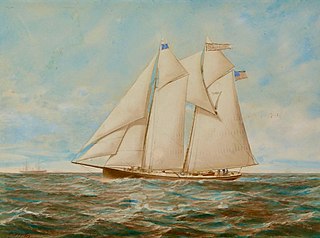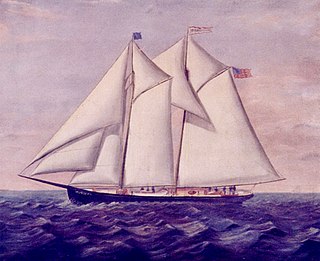
City Ice Boat No. 3, commonly known as Ice Boat No. 3 or just No. 3, was a municipal sidewheel icebreaker built in 1873 to assist in keeping Philadelphia's waterways free of ice during the winter months. The vessel was also used for occasional excursions and other duties through the rest of the year.

The Edward C. Knight, also known as the E. C. Knight, was a 19th-century pilot boat built by the C. & R. Poillon shipyard in 1875 for the Delaware River Pilots. She was the finest and fastest pilot-boat belonging to the Philadelphia port. She was sold to the Brunswick Pilots' Association of Georgia in 1898.

The Adams was a 19th-century Boston pilot boat, built in 1888 by Moses Adams at Essex, Massachusetts for Captain John H. Jeffries. She was named for Melvin O. Adams, an American attorney and railroad executive. Her design was by yacht designer Edward Burgess, known for his America's Cup defenders. In 1901, she was one of only five pilot-boats left in the Boston fleet. In 1912, she was sold to haul gravel to Boston, then sold again where she landed in the Portuguese immigrant trade. She was sunk by enemy action during World War I.

The Varuna was a 19th-century Boston pilot boat, built by Montgomery & Howard at Chelsea, Massachusetts in 1890, for a group of Boston pilots. She was designed by yacht designer Edward Burgess, known for his America's Cup defenders. She was the first centerboard pilot-boat in operation in the Massachusetts Bay. The Varuna went out of service in 1912 because of the introduction of steam power into pilot-boats. She was later sold to Stephen Simmons to be used as a trading vessel between ports in the Spanish Main in 1913.

The Jesse Carll was a 19th-century pilot boat, built in 1885 by Jesse Carll at Northport, New York, for George H. Sisco. She was one of the largest vessels ever built in the Sandy Hook service. She was named in honor of Jesse Carll, a well-known Northport shipbuilder. In 1896, in the age of steam, the Ezra Nye, along with other pilot boats, were replaced with steamboats.

The Christian Bergh was a 19th-century Sandy Hook pilot boat built in 1851 at the Westervelt & Co. shipyard. She later became a Pennsylvania pilot boat until her service ended in 1886 when she became an oyster boat in the Delaware Bay. She was named after Christian Bergh a prominent shipbuilder in New York and a close friend of Jacob Westervelt.

The Edward E. Barrett, or Edward E. Bartlett, was a 19th-century two-masted Sandy Hook pilot boat, built by C. & R. Poillon in 1883 and designed by William Townsend. She helped transport New Jersey maritime pilots between inbound or outbound ships coming into the New York Harbor. She was one of the pilot boats that survived the Great Blizzard of 1888. In the age of steam, the Barrett ended her pilot commission and was sold in 1904.

The David Carll was a 19th-century pilot boat, built in 1885 at the David Carll shipyard in City Island, New York. She was named in honor of David Carll, a well-known City Island shipbuilder. The David Carll was considered to be among the fastest schooners in the fleet. She was built to replace the Mary E. Fish that was run down and sank by the schooner Frank Harrington in 1885. She was one of the pilot boats that survived the Great Blizzard of 1888. The David Carll was lost at sea in 1893.

The Edmund Driggs was a 19th-century Sandy Hook pilot boat built in 1864 at the Edward F. Williams shipyard in Greenpoint, Brooklyn. She was built to replace the pilot boat Elwood Walter. The schooner was used to pilot vessels to and from the Port of New York. She survived the Great Blizzard of 1888. In the age of steam, she was sold in 1896.

The Sandy Hook was a steam pilot boat built in 1902, by Lewis Nixon at the Crescent Shipyard in Elizabeth, New Jersey. In 1914, she was purchased by the New York and New Jersey Sandy Hook Pilots Association to replace the pilot boat New Jersey, that was lost in 1914. She could carry 10 to 12 pilots that would help guide ships through the New York Harbor. The Norwegian America Line Oslofjord, with the Crown Prince Olav of Norway and Princess Märtha of Sweden on board, ran into and sank the Sandy Hook in 1939.

Favorite or Favorita, was a 19th-century New York Sandy Hook pilot boat built in the early 1820s. She helped transport New York City maritime pilots between inbound or outbound ships coming into the New York Harbor. Favorite collided with a United States steamer and sank in 1865 near Barnegat Lighthouse.
James Callahan was a 19th-century American New York Sandy Hook Pilot. He is well known for being one of the oldest Sandy Hook pilots, having served for 38 years. He was owner and operator of the William Bell that was captured and burned by the Confederate raiding steamer CSS Tallahassee during the American Civil War.
The Pilots' Association For The Bay & River Delaware is the official maritime pilot group for the Delaware Bay and Delaware River. The association is one of the oldest state pilot organizations in the nation that was founded in 1896. Delaware Bay Pilots are licensed maritime pilots for the Delaware Bay and River. Delaware pilots guide oceangoing vessels, passenger liners, freighters and tankers in and out of the harbor. The Delaware Bay is bordered inland by the States of New Jersey and Delaware, and the Delaware Capes, Cape Henlopen to the south and Cape May to the north, on the Atlantic Ocean.

The Thomas Howard was a 19th-century pilot boat built by the William Cramp & Sons in 1870 for the Philadelphia Pilots' Association. She was the finest and fastest pilot-boat belonging to the Philadelphia port. In 1886, the Pilots' Association for the State of Delaware declared that the Thomas Howard become a Delaware pilot boat.

The Thomas F. Bayard was a 19th-century Delaware River pilot schooner built by C. & R. Poillon shipyard in 1880. She spent sixteen years as a pilot boat before being sold during the Yukon Gold Rush in 1897. She was sold again in 1906 for Seal hunting, then purchased by the Department of Marine & Fisheries where she guided freighters into New Westminster, British Columbia for 43 years. She was then acquired by the Vancouver Maritime Museum in 1978. When she sank at her mooring in 2002, the International Yacht Restoration School, Mystic Seaport and the Vancouver Maritime Museum, removed the vessel in pieces for the archeological teams to study and document the remains of her hull. The Thomas F. Bayard Collection, at the Vancouver Maritime Museum, contains the documents, history and preservation efforts.

The John G. Whilldin was a 19th-century Pennsylvania pilot schooner built in 1839 by the Joseph Vogle shipyard of Southwark, Philadelphia. In 1893, the Board of Port Wardens of Philadelphia recognized only four pilot boats for the Port of Philadelphia, the E. C. Knight, John G. Whilldin,William W. Ker and J. Henry Edmunds. On September 8, 1915, the Whilldin was reported as wrecked near Port St. Joe, Florida.

The Enoch Turley was a 19th-century Pennsylvania pilot schooner built in 1842 in Baltimore, Maryland. In the 1880s she was caught up in the competition and rivalry between New Jersey and Pennsylvania pilots and the Delaware pilots. She survived the Great Blizzard of 1888, but was swept away in 1889, with all hands lost, during a powerful gale.

The Ebe W. Tunnell was a 19th-century Delaware pilot schooner built in 1887 in Brooklyn, New York. In 1889, the Tunnell was driven out to sea in a fierce storm. The crew spent five days in turbulent waters before they were rescued. In the age of steam, Ebe W. Tunnell had outlived its usefulness and was sold as a houseboat for a group of men working in the Chesapeake Bay in 1909.

The J. Henry Edmunds was a 19th-century pilot schooner built in 1887 in Brooklyn, New York for Philadelphia pilots. She sank in 1892 and a second Edmunds was built in 1893, which lasted thirty-five years before she sank in bad weather outside Cape Henlopen in 1928. She was the last schooner-rigged pilot boat in the Delaware Bay.


















